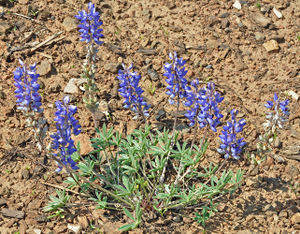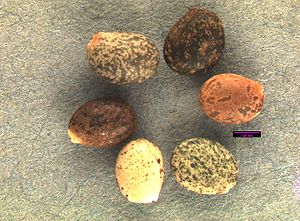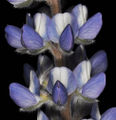Lupinus lepidus var. lepidus
- Latin Name: Lupinus lepidus var. lepidus
- Family: Fabaceae
- Common Names: prairie lupine
- Synonyms/Misapplications: L. minimus
- Codon: LUPLEP
Contents
Taxonomy
| Lupinus lepidus var. lepidus | |
|---|---|

| |
| Photo by Robert L. Carr. Also featured on Main Page. | |
| Scientific classification | |
| Kingdom: | Plantae |
| Subkingdom: | Viridiplantae |
| Phylum: | Tracheophyta |
| Subphylum: | Spermatophytina |
| Class: | Magnoliopsida |
| Subclass: | Rosanae |
| Order: | Fabales |
| Family: | Fabaceae |
| Genus: | Lupinus L. |
| Species: | Lupinus lepidus Douglas ex Lindl. |
| Subspecies: | Lupinus lepidus var. lepidus |
Description
Low and spreading native perennial herb, generally less than 3 dm.
Leaves are both basal and caulescent, palmately compound, and covered with fine hairs on both surfaces.[1]
The racemes are generally exserted well beyond longest leaves, as opposed to L. lepidus var. cusickii and L. lepidus var. utahensis. [2]
The flowers are dark blue to purple, sometimes white.[3] Inflorescence bracts are often quickly deciduous.[2]
Pods are hairy, from 10-20 cm long, containing 2-12 seeds.[4]
L. lepidus has several variants.
According to Flora of the Pacific Northwest, "Perennial lupines in North America form a taxonomically difficult group in which some species boundaries are blurred by wide-spread interbreeding; not all plants will readily key."[2]
Basic Explanations and Assumptions:
The dimensions for the seeds are length x width x depth. The location of the hilum is used as the base of the seed, and the length is measured from hilum to the opposite apex. Where a style is present, the length is measured from the hilum to the bottom of the style. Width is measured at a right angle to the length at the widest part. Depth is measured at a right angle to the intersection of height and width lines.
Measurements included are the mean average for each measurement of ten separate seeds.
All measurements in millimeters unless otherwise noted.
Distribution
Western Cascades, southern BC to western Oregon.[2]
Habitat
Lowland prairies.[2]
Prairie lupine was the first plant to colonize the devastated slopes of Mount St. Helens. It's seeds are probably dispersed by explosive dehiscence (bursting of the seed pods) and rolling, or by erosion and deposition.[5]
Species associated with Prairie lupine include houndstongue hawkweed (Hieracium scouleri), cutleaf microseris (Microseris laciniata), coast goldenrod (Solidago spathulata), white-top aster (Aster curtus), slender cinquefoil (Potentilla gracilis), field woodrush (Luzula campestris), and common camas (Camassia quamash). Latin names updated by editor.[3]
Uses
Other species in the Lupinus genus are important food plants in the Salish Sea. In Keeping it Living, many propagation practices of different Lupinus species, such as L. nootkanensis, are detailed.[6]
Propagation
Sow lupine seeds in potting soil mixture of coarse and fine particles. Like other legumes, prairie lupine has root nodules which house bacteria which fix nitrogen, providing fertilizer for the plant. Potting soil can be inoculated by mixing a small amount of soil from the seed collection site in the potting mix. Use low nitrogen fertilizer and no humus. Plant seeds singularly in long narrow pots (at least 3”) and transplant from pots into the field within the same year (about 8 months). Lupine seedlings have very sensitive roots and suffer from root damage when handled excessively. Sensitivity to the root system is especially needed when transplanting from nursery containers into the field. Mist lightly, daily with restricted water.[3]
Seed
Seed sample from: 2011
Average Measurement: 2.7 x 1.8 x 1.3
Measurement Range: L: 2 - 3, W: 1.5 - 2, D: 1 - 1.5
Features
Color: Seeds ranging in color from off-white, tan, brown, to gray. Lots of variation in color. Patterned with mottled speckling which is light to dense. Speckles light brown to dark brown.
Surface: Seed surface is smooth and glossy. Some seeds have small concave pockets.
Latitudinal Cross Section: elliptical ![]()
Longitudinal Cross Section: elliptical [[File:LULE-long-crosssection.png Flowering, Fruiting and Seed Characteristics Flowering Time: June - Aug
Fruit Ripening Time: Spring - Fall
Seed Collection Time: June - Aug
Crop Intervals: Perennial
No. of seeds per pound: 16000
Seed Viability
Fruit and Seed Collection and Extraction
Seed can be hand collected from June to August, but collecting is slow due to the small size of the plant. Seeds should be dried in the pods in paper bags. Cuttings can also be taken from the side shoots of hardened stems in the spring.[3]
Seed Storage
Lupine seeds have a hard seed coat, and because related lupine species are known to have long-lived dormant seed banks (e.g. L. arboreus was germinated in a seed bank study after 45 years), it is likely that prairie lupine seeds are also long-lived and can be stored at low moisture and temperature levels for several years.[3]
Fruit/Seed Dormancy and Treatment
Seed requires scarification.[3]
Citations
- ↑ Bowcutt, F., & Hamman, Sarah. (2016). Vascular plants of the South Sound prairies (First ed.). Olympia, Washington: The Evergreen State College Press.
- ↑ 2.0 2.1 2.2 2.3 2.4 Hitchcock, C. L., Cronquist, A., Giblin, D., & Legler, B. et al. (2018). Flora of the Pacific Northwest: an illustrated manual. Seattle: University of Washington Press.
- ↑ 3.0 3.1 3.2 3.3 3.4 3.5 Lambert, A. (2003). Propagation Protocol Lupinis Lepidus (rep.). Propagation Protocol Lupinis Lepidus. Retrieved from https://depts.washington.edu/propplnt/Plants/Lupinus%20lepidus.htm
- ↑ Gilkey, H. M., & Johnston, L. D. (1980). Handbook of Northwestern plants. Oregon State University Bookstores.
- ↑ Crisafulli, C. M., Dale, V. H., & Swanson, F. J. (2005). 11: Causes and Consequences of Herbivory on Prairie Lupine (Lupinus lepidus) in Early Primary Succession. In Ecological Responses to the 1980 Eruption of Mount St. Helens. essay, Springer Science+Business Media, Inc.
- ↑ Deur, D. E., & Turner, N. J. (Eds.). (2006). Keeping it living : Traditions of plant use and cultivation on the northwest coast of north america. Retrieved from https://ebookcentral-proquest-com.evergreen.idm.oclc.org




